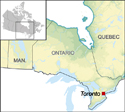Toronto’s Heat Health Alert System

Photo courtesy of Sean Robertson
PROACTIVE ADAPTATION CAN HELP SAVE LIVES NOW AND PREPARE FOR FUTURE CLIMATE CHANGE
The City of Toronto has developed and implemented two extreme weather alert systems: Extreme-Cold Weather Alerts (in 1996), and Heat Health Alerts (in 2001). These systems are designed to protect the city’s most vulnerable populations – the elderly, children, medically at-risk persons, and the homeless – from extremes of heat and cold. The Heat Health Alert System was developed proactively, in part as a response to the disastrous heat waves in Chicago (1995) and Philadelphia (1993), both of which killed hundreds of urban residents.
Populations at risk from extreme heat
The health risks increase substantially when people experience prolonged exposure to heat without significant cooling intervals. Socially isolated seniors are at highest risk of heat-related illness and death. Other at-risk groups include children, people with chronic and pre-existing illnesses including mental illness, low-income households, and adults who are marginally housed or homeless.
Environment Canada projects that by the latter part of this century, Toronto will average 65 days per year where the temperature exceeds 30°C, more than four times the historic average between 1961 and 1990. This represents a critical concern that will disproportionately impact the health and wellbeing of the city’s more vulnerable populations.
Toronto has had a heat warning system since 1999. The first heat warning system used a threshold of a one-day forecast of humidex over 40°C. Since 2001, Toronto Public Health has adopted the Heat Health Alert System as the basis for declaring alerts. This system is based on a synoptic approach that assesses the historical relationship between mortality levels and weather conditions.
Toronto’s Heat Health Alert System includes a three-day forecast outlook. This synoptic-based approach starts with an air mass categorization for each forecast day based on weather conditions (temperature, humidex, dew point, wind speed and direction, air pressure and cloud cover). Then an algorithm is run to predict the likelihood of excess mortality under these air mass conditions; it is this likelihood that determines whether the Heat Health Alert System forecasts an Extreme Heat Alert, a Heat Alert or neither.
The Toronto Medical Officer of Health issues a “Heat Alert” when the likelihood of excess weather-related mortality exceeds 65 percent and an “Extreme Heat Alert” when the likelihood of excess weather-related mortality exceeds 90 percent.
At the beginning of the summer, the City of Toronto and its partners provide the public with targeted information on the risks of extreme heat and on precautions to prevent heat-related illness and death. Various brochures are distributed and are available on the City’s Web site. Declaration of an alert by Toronto’s Medical Officer of Health activates specific responses under the City of Toronto Hot Weather Response Plan, which includes
- contacting local media to inform the public that a heat alert has been issued
- notifying community agencies and other response partners of the alert status, in order for them to implement agency specific protocols
- operating, through the Canadian Red Cross, a heat information line from 9 a.m. to 9 p.m. for those in need of assistance or with heat-related inquiries
- distributing bottled water through the Canadian Red Cross, targeting vulnerable people and providing water to agencies that work with vulnerable groups
- distributing Toronto Transit Commission (TTC) tokens through selected drop-in centres to the homeless so they can reach cooling centres
- opening seven designated cooling centres (one open for 24 hours) at public locations, such as community centres and civic centres, during an Extreme Heat Alert

Photo courtesy of Stephan Powell
Toronto Public Health (TPH) conducts an annual review of the City’s hot weather response. Recent changes to the plan include an increase in the number of cooling centres and an increase in the number of transit tokens distributed to people in need of transportation to a cool place. TPH also received funding from NRCan in 2010 to develop a map-based decision support tool for public health staff and community partners to improve the delivery of health-protective services to the most vulnerable populations during extreme heat events.
In addition to the Heat Health Alert System, the City has implemented various programs that include measures aimed at reducing the effects of heat waves by implementing tools aimed at cooling the city over the long term. These programs include a Green Roof Bylaw, the Toronto Green Standard, an Eco-Roof Incentive Program, Doubling the Tree Canopy Initiative, and ”Greening” Surface Parking Lot guidelines. Many of these actions will help reduce the urban heat island effect, which occurs in urban areas where dark surfaces such as asphalt and roofing absorb the sun’s energy and radiate it out, thereby further warming the local ambient air.
Heat vulnerability mapping tool
Toronto Public Health (TPH) is developing a mapping tool to visualize human vulnerability to extreme heat. The maps will incorporate numerous indicators of vulnerability, including surface temperatures, green space coverage, housing and social characteristics of at-risk populations, access to air conditioning, and the location of cool places. Due to be completed in 2011, the tool will help TPH and community partners identify and prioritize geographic hot spots for delivering resources during a heat alert. The City of Toronto also plans to use the tool for long-term climate adaptation planning.
Toronto’s Hot Weather Response Plan has increased awareness of problems related to extreme heat, contributed to the development of new programs and measures to combat the urban heat island effect, and helped facilitate the partnering of various City departments, non-governmental organizations and other local groups. The City is now developing a Climate Change Risk Assessment process and electronic tool to be used in a variety of City Divisions. The process will include consideration of many extreme weather indicators, including extreme heat. The results of the risk assessment will enable staff to prioritize climate change risks and prepare appropriate adaptive actions.
Contact:
Elaine Pacheco
Manager, Healthy Environments Toronto Public Health Tel.: 416-338-8047 E-mail: epacheco@toronto.ca
Stephanie Gower
Research Consultant Environmental Protection Office Toronto Public Health Tel.: 416-338-8101 E-mail: sgower@toronto.ca
Page details
- Date modified:
